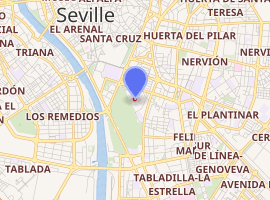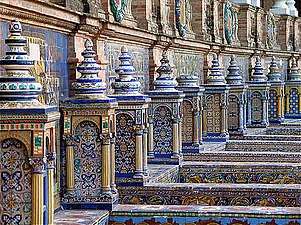Plaza de España, Seville
The Plaza de España ("Spain Square", in English) is a plaza in the Parque de María Luisa (Maria Luisa Park), in Seville, Spain, built in 1928 for the Ibero-American Exposition of 1929. It is a landmark example of the Regionalism Architecture, mixing elements of the Baroque Revival, Renaissance Revival and Moorish Revival (Neo-Mudéjar) styles of Spanish architecture.[1]
| Plaza de España de Sevilla | |
|---|---|
_-_01.jpg) Building at the Plaza at sunset | |

| |
| General information | |
| Architectural style | Spanish Regionalism, mixing Spanish Renaissance Revival, Spanish Baroque Revival and Neo-Mudéjar styles |
| Town or city | Seville |
| Country | Spain |
| Completed | 1928 |
| Client | Alfonso XIII |
| Technical details | |
| Floor area | 45,932 m2 (494,410 sq ft) |
| Design and construction | |
| Architect | Aníbal González |
History

Maria Luisa Park
In 1929, Seville hosted the Ibero-American Exposition World's Fair, located in the celebrated Maria Luisa Park (Parque de María Luisa). The park gardens were designed by Jean-Claude Nicolas Forestier.[2] The entire southern end of the city was redeveloped into an expanse of gardens and grand boulevards. The centre of it is Parque de María Luisa, a "Moorish paradisical style" with a half mile of tiled fountains, pavilions, walls, ponds, benches, and exhedras; lush plantings of palms, orange trees, Mediterranean pines, and stylized flower beds; and with vine hidden bowers. Numerous buildings were constructed in it for the exhibition.[3]
Plaza de España
The Plaza de España, designed by Aníbal González, was a principal building built on the Maria Luisa Park's edge to showcase Spain's industry and technology exhibits. González combined a mix of 1920s Art Deco and Spanish Renaissance Revival, Spanish Baroque Revival and Neo-Mudéjar styles. The Plaza de España complex is a huge half-circle with buildings continually running around the edge accessible over the moat by numerous bridges representing the four ancient kingdoms of Spain. In the centre is the Vicente Traver fountain. By the walls of the Plaza are many tiled alcoves, each representing a different province of Spain.[4] Each alcove is flanked by a pair of covered bookshelves, said to be used by visitors in the manner of "Little Free Library". Each bookshelf often contains information about their province, yet you can often find regular books as well for some people have taken to donating their favorite book to these shelves.
Today the Plaza de España mainly consists of Government buildings. The central government departments, with sensitive adaptive redesign, are located within it. The Plaza's tiled Alcoves of the Provinces are backdrops for visitors' portrait photographs, taken in their own home province's alcove. Towards the end of the park, the grandest mansions from the fair have been adapted as museums. The farthest contains the city's archaeology collections. The main exhibits are Roman mosaics and artefacts from nearby Italica.
The Plaza de España has been used as a filming location, including scenes for the 1962 film Lawrence of Arabia. The building was used as a location in the Star Wars movie series Star Wars: Episode II – Attack of the Clones (2002) — in which it featured in exterior shots of the City of Theed on the Planet Naboo.[5] It also featured in the 2012 film The Dictator.
The plaza was used as a set for the video of Simply Red's song Something Got Me Started.
Restoration
From 2007 to 2010, the Seville City Council invested 9 million euros in the restoration of the Plaza de España. The objective was to recover the original monument as the architect, Aníbal González; conceived it. [6] To restore it, the restoration team worked to recover pieces like the ceramic streetlights, benches or even pavements. The reproduction was made based on photographs and postcards from the municipal newspaper library. Cefoarte and Diaz Cubero were some of the experts who, in multidisciplinary teams; achieved the challenge of bringing back to life the Plaza de España. [7]
.jpg) North tower and river
North tower and river The tiled Provincial Alcoves along the walls of the Plaza de España
The tiled Provincial Alcoves along the walls of the Plaza de España.jpg) South Wing of the Plaza
South Wing of the Plaza
Panoramics
See also
References
| Wikimedia Commons has media related to |
- http://www.sevilla5.com/monuments/plespana.html Sevilla-Plaza de España accessed 4/08/2010
- Sevilla-Parque de Maria Luisa. accessed 4/08/2010.
- http://www.andalucia.com/cities/seville/marialuisapark.htm Maria Luisa Park, Seville accessed 4/09/2010
- http://www.andalucia.com/cities/seville/plazadeespana.htm Plaza de España, Seville accessed 4/09/2010
- Symington, Andy (2004). "Sevilla". Andalucia (4. ed.). Bath: Footprint Handbooks. p. 76. ISBN 9781903471876.
- Sevilla-Parque de Maria Luisa. accessed 10/10/2019.
- "Diaz Cubero". Diaz Cubero SA. Retrieved 11 October 2019.


